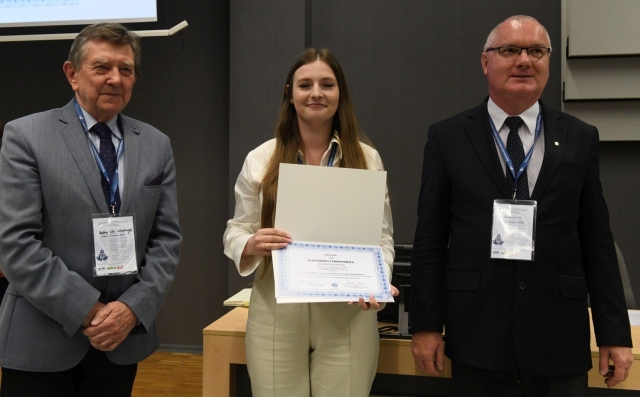Article about FLASH appreciated by SEP
2023.06.21 12:30 - Piotr SpinalskiPromising results of the first studies and tests of radiotherapy using ultra-high FLASH dose rates mean that interest in this technique is constantly growing. Research in this field is appreciated, as confirmed by the award received recently for an article on FLASH therapy by scientists from the NCBJ Nuclear Equipment Department.
"FLASH therapy: a new miracle in cancer radiotherapy?" is an article by Aleksandra Lenartowicz, Janusz Pracz and Vasyl Markopolski, which has just won second prize in the Competition named after prof. Mieczysław Pożaryski "For the best articles published in journals – organs of SEP" (Stowarzyszenie Elektryków Polskich – Association of Polish Electrical Engineers) in 2022. The authors described in detail an innovative technique of radiotherapy with ultra-high dose rates called FLASH radiotherapy, in which the effect of sparing healthy tissues is observed while maintaining a high level of destroying cancer cells. The article characterizes the current state of knowledge about this method, devices and conditions necessary for the FLASH effect to occur, and based on the literature, promising directions for the development of both preclinical and clinical research as well as challenges for physics and acceleration techniques are identified. To date, many radiobiological and preclinical studies have been carried out using radiation with high dose rates (≥40 Gy/s), showing, among others, neuroprotection during whole-brain irradiation in mice, and in one study conducted on mammals, milder skin reactions were observed in a miniature pig when irradiated using the FLASH technique. The first and so far only clinical trial using a high-dose electron beam was also conducted, in which a 75-year-old patient with cutaneous lymphoma, who had previously been repeatedly treated with classical radiotherapy methods, was irradiated. The tumor response was rapid, complete and durable. This result, as well as other preclinical and radiobiological studies, gave hope for the wide clinical application of the FLASH technique.
"There are many radiobiological and preclinical studies, as well as expanded clinical trials involving humans, but little attention is paid to the device itself, because there are only two devices of this type commercially available in the world, and most of the research so far has been performed on modified medical devices." – emphasizes Aleksandra Lenartowicz, who accepted the award on behalf of the team. To fully exploit the potential of this technique and enable its implementation into clinical use, it is necessary to elucidate the biological mechanisms of sparing healthy tissues while maintaining a high level of destruction of cancer cells, as observed in previous studies. Scientists from the NCBJ Nuclear Equipment Department addressed the topic of devices generating electron radiation with ultra-high dose rates, and also started the first work and preliminary research on this technique. On this basis, in cooperation with the Wielkopolska Oncology Center and the Institute of Nuclear Chemistry and Technology, NCBJ started the project "Construction and validation of an electron beam generating station with ultra-high dose rate (FLASH RT)", the aim of which is to design and manufacture an accelerator emitting an electron beam with ultra-high dose rate and a dedicated research station. “This position will increase the availability and quality of tests using ultra-high dose rates. We already see a huge need for intensified research using FLASH radiation to enable the use of this type of radiation in radiotherapy as soon as possible," adds M.A. Lenartowicz.
Award-winning article:
Lenartowicz A, Pracz J, Markopolskyi V, FLASH therapy: a new miracle in radiotherapy of malignant tumors? Electronics: structures, technologies, applications vol. 63, No. 2, 27–30. 2022.
We also wrote about the FLASH therapy accelerator in the article: https://old.ncbj.gov.pl/aktualnosci/akcelerator-typu-flash-nowa-metoda-walki-rakiem


















